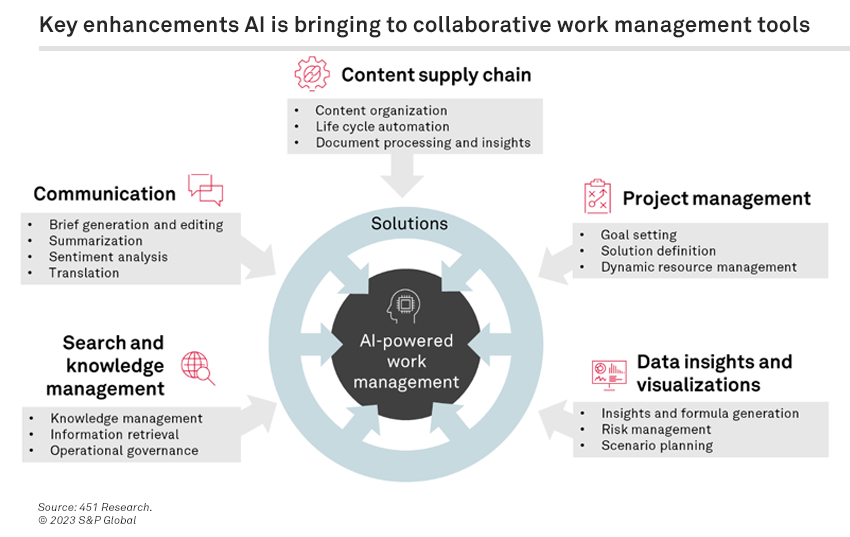
Collaborative work management (CWM) tools are not new to artificial intelligence, but it is only now with the rise of generative AI that we are seeing a significant impact. According to our Workforce Productivity & Collaboration, Work Execution Goals & Challenges 2023 survey, employees particularly crave tools that diminish repetitive tasks, streamline information sharing, and help them better design and plan their work.
Currently, generative AI is mostly addressing these pain points with isolated functionalities, but over time, we will see a more integrated set of solution enhancements to the utility of CWM tools. In this report, we explore five critical dimensions through which AI is leveling up the category by optimizing project and solution management, generating data insight and visualizations, enhancing search and knowledge discovery, powering content supply chains, and improving communication.
The Take
AI, particularly generative AI, has significant potential to amplify the benefits of CWM tools. While flexibility has always been a major strength of CWM tools, the sheer variety of features, templates and use cases can be overwhelming for users. AI can streamline this complexity, propelling users to innovate and craft custom, scaled business solutions. As the competitive sphere intensifies, and as newer productivity tools powered by large language models (LLMs) or unique models emerge with novel propositions, CWM needs to double down on AI and cement itself as an essential enterprise technology. Vendors should grasp this opportunity to not only drive more revenue from their customers, but also to find the vision that has been lacking across the category. This vision needs to speak to those enterprises and senior business leaders who are yearning for strategic technologies that boost organizational alignment, enhance cross-functional decision-making, and expedite execution.
Project and solution optimization
Many pain points exist across project management processes. Our survey showed that for 35% of employees, the main improvements they want are those that allow them to be more agile — aligning strategy, goals and execution better; having flexible governance to speed up delivery; or being able to change direction when new circumstances arise. For 21%, it is about generally having more automation to raise their own productivity. For 20%, it is having better ways to manage resources across project life cycles. Vendors are now leveraging AI to address these friction areas.

In 2024, Asana Inc. plans to release a feature called Smart Goals, which uses generative AI to streamline goal setting, offering recommendations that can be tailored to organizational frameworks. Todoist’s AI suggests actionable tasks based on specific goals, while Monday.com Inc. can recommend project plans based on specified inputs and goals. Startup Trevor uses AI along with integrations with task management and calendar apps to aid users from executives to freelancers with intelligent scheduling. Goal setting and management is more difficult than many realize. In fact, doing this across different teams is the second biggest challenge employees face when planning their important projects, after finding the right resources to execute their plans.
There is a big opportunity for those vendors with premium capabilities to apply AI to how more complex solutions are built in CWM tools. Monday, for example, is releasing an AI-powered solution builder to help users integrate and create workflows between Monday and other third-party apps. Similarly, Smartsheet Inc. employs AI for proactive recommendations around solutions, based on user history, and can respond to specific queries such as how to better monitor the health of their projects. Quickbase, the no-code platform that is a newcomer to the work management category, offers a Smart Builder that suggests design elements during project creation.
Airtable is also developing features to automate crucial steps in workflows, such as swiftly categorizing customer feedback and generating product specs, or categorizing budget spend. Wrike’s AI offers proactive guidance to avoid repeatable and manual tasks, while ClickUp is focusing its AI assistant on tailoring recommendations for specific roles like sales and marketing, products, or engineering. Asana is also planning to use AI to auto-generate custom fields, create workflows from language prompts, and optimize workloads in support of more complex project and resource management scenarios.
Taskade is another AI-powered productivity startup. Building on top of an LLM, it aims to use generative AI to create not just task lists, but mind maps, documents and custom workflows. Another promising entrant is Adept. Founded in 2022, it has received $350 million in funding, and is focused on building its own model, ACT-1. Its goal is to work with all software, web apps and APIs to take a team’s goals in plain language and convert them into actions across a user’s devices and applications. A simple example would be using one language prompt rather than having to do multiple clicks in a CRM tool to log a call with added context, and follow-on actions defined in an automated workflow.
Data insight and visualizations
Using generative AI in CWM tools can drastically improve data insight and visualizations. For instance, Smartsheet will soon be able to handle up to 20,000 projects in a portfolio. Using queries like “which projects are over budget?” it can simplify large-scale portfolio management. Smartsheet, Monday and Quickbase also employ AI to assist in formula creation, expediting the time a user takes to get to insight on their data, in lieu of having to figure out which formula can return the analysis they need.
Zoho’s CRM app, combined with its Zia AI assistant, can be used to evaluate sales patterns to suggest upselling products, while the results get tracked via the native integration with Zoho’s Projects app. Asana’s forthcoming Smart status and Smart answers features will harness its Work Graph data to pinpoint project hindrances, risks and unresolved queries; other planned features will focus on scenario planning and dynamic resource management based on historical and future capacity.
Our survey showed that this kind of capability will be important to help employees prioritize what they need to focus on — 52% struggle with having too much work, not being able to meet deadlines or not knowing what to prioritize when it comes to the various items on their plate. Planview has pointed to the use case of doing sentiment analysis to associate negative feelings — for example, with project inefficiencies, offering teams richer context for addressing challenges.
AI is being used to enhance CWM tools by spotting trends, facilitating decisions and offering comprehensive project overviews. It amplifies the potential of data, and is therefore likely to propel the strategic adoption of CWM tools.
Search and knowledge management
CWM vendors also use AI to enhance information accessibility within their tools. Atlassian Corp. highlights the challenge of deciphering abbreviations, acronyms and specific terms in its Confluence tool. To address this, it uses AI to provide definitions without users needing to leave the main content. Dust is a French productivity startup cofounded by a former research engineer at OpenAI (one of the key contributors to the emergence of generative AI). Dust integrates data from other productivity and collaboration apps, allowing users to conduct semantic searches to better access organizational knowledge.
Qatalog, a British firm, presents its Enterprise Intelligence platform as a unified workspace emphasizing coordination, collaboration and operational workflows. Unique to Qatalog is its AI-powered search, which connects with third-party apps and delivers personalized results based on user role and data source without traditional indexing. Glean, established by former Google search engineers, centers on adaptive AI to bolster organizational knowledge management. Its focus spans use cases like keeping teams aligned, enhancing sales context, expediting engineering issue resolutions, and aiding data governance by identifying overly exposed sensitive content.
Content supply chain
AI’s influence on work management is also evident among those vendors heavily supporting content-centric processes. Adobe Inc.’s GenStudio solution integrates generative AI and intelligent automation across its product range, facilitating faster content ideation, collaboration, production, deployment and optimization.
Smartsheet Inc.’s Brandfolder, a digital asset management tool, utilizes an AI engine to expedite content retrieval and automate tagging and classification of digital assets. With generative AI, it will be able to produce unique descriptions for various product SKUs cataloged via data asset management. At its recent Engage conference, Smartsheet announced that those content management capabilities will become part of the core Smartsheet experience, which will allow for a closer integration with its project and resource management capabilities, and with custom solutions that users build on the platform.
Box AI, currently in beta, is focused on aiding users in summarizing large volumes of information, generating new content, extracting insight from mixed-format documents, and enhancing search capabilities, especially in pinpointing critical document clauses and terms. For frontline and field tasks, Wrike employs optical character recognition, whereby users can turn to Wrike’s mobile apps to convert paper documents into editable digital text files.
Communication
CWM tools are using generative AI capabilities for text generation and editing: summarizing meeting notes and comment threads, adjusting message tones, and creating detailed briefs and plans from various inputs. For instance, Monday aids in email composition within its CRM tool Notion, a writing assistant that facilitates writing and idea extraction from notes, while Zoho’s Zia translates chats, emails and other messages into 16 languages. Planview highlights how AI can be used to summarize unstructured discussions and complex projects with highly structured task hierarchies, offering a snapshot without having to deep dive into specific tasks and plans.
Conclusion
AI stands at the forefront of the next transformative wave in CWM technologies, as companies look to add to the enterprise scale many have built into their products, as well as to pioneer custom solutions that resonate with evolving enterprise needs. By streamlining goal management — removing the burden in task maintenance, helping create and optimize solutions and workflows, and making resource management and scenario planning a more embedded part of business solutions — AI is setting the stage for a revolution in work management.
Enhanced search, knowledge management and data insight will not only sharpen strategic decisions in the business solutions users create, but also propel advanced solutions design, and with it greater data management proficiency. For those teams managing complex content supply chains, these synthesized capabilities should offer an unprecedented level of control and efficiency. Ultimately, AI in CWM tools can supercharge teams with more robust, adaptive and insightful work management practices.
Want insights on workforce productivity and collaboration trends delivered to your inbox? Join the 451 Alliance.

